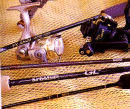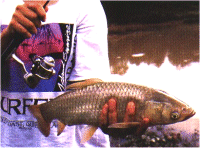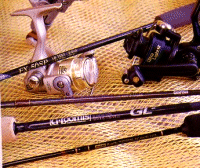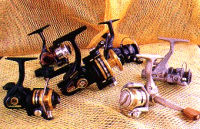



 Screaming Drags!
Screaming Drags!
by Chris Tan A gentle bump on the line and the line slowly grew tight. Picking up my rod carefully, I could feel the fish slowly swimming off with the bait. I gave a firm strike. Immediately it took off at high speed with the sweet sound of the drag screaming. The fish headed towards a clump of weeds forty feet away. With the drag still peeling off, I quickly started short smooth pumps to turn it. Just a few feet short of the snags it stopped and slowly turned, moving at a right angle to me. By keeping the pressure on, I managed to recover some line. However, the fish was still strong, it streaked off again. A minute or so later I managed to bring it in close to the bank. Before I could net it, it shot off again. A couple of minutes later, with careful manoeuvring, it was safely in the net.  What fish? What was this strong fighting fish? Surely not a kelah? May be a sebarau, or even a toman? Well not any of those. It was a carp! A common grass carp, weighing about two kilos, but why the screaming drags and a fight taking five minutes! Well try using one kilo test line!
What fish? What was this strong fighting fish? Surely not a kelah? May be a sebarau, or even a toman? Well not any of those. It was a carp! A common grass carp, weighing about two kilos, but why the screaming drags and a fight taking five minutes! Well try using one kilo test line!
A challenge Pond fishing is viewed by some as a slow and boring style of angling for fish that do not give much fight. But for me, by lowering the line class it makes it even more challenging to try to land toman or sebarau, or saltwater fish! Many of us fish for sport, but landing a fish weighing a kilo with six kilo line does not give as much challenge compared to using ultralight tackle (generally ultralight tackle is regarded as using line classes of two kilos and below). Previously I had been fishing at ponds with three kilo line, but hooking up tilapias and lampam and the occasional carp became a lack lustre affair of just winding in the fish on a bouncing rod as the fish struggled. I also noticed that my catch rate had also been deteriorating. My suspicion was that the fish were getting more wary. Some of my friends had been using 1 kilo test line for some time, but at that time obtaining such light line in Malaysia could be a problem. Few tackle shops stocked one kilo test line. It took some hunting but I finally managed to pick up some one kilo line, and purchased a rod and reel to balance the outfit. Catch rate going up Immediately my catch rate went up! I was getting bites and hook ups like never before! Tilapia, lampam jawa, grass carp and even a jelawat! The reason for this was due to the thinner diameter of the line. Advantages of ultralight line With the thin line diameter, the line becomes harder to see or sense! In other words the fish becomes less aware that there is something amiss with the bait, therefore there is a greater chance for the fish to attempt to pick up the bait. Thin line also allows the fish to pick up and swallow the bait without feeling any resistance, Moreover its thinness creates minimal drag in the water. A heavier line with a larger diameter creates more drag in the water. The fish would feel the drag caused by the line as it picks up the bait, thus a wary fish would most likely drop the bait instead of continuing to swallow the bait in. Frequently, other anglers would be sitting a few yards away, without a single bite, their baits soaking for more than an hour, without a single twitch on their line. Upon observation, it was clear that the line they were using was at least six to seven kilos in class. By contrast a friend and I had been pulling in tilapia and lampam every few minutes. Also, due to the light line, we had been having great little fights, although the fishes were not very large. The small diameter of ultralight line creates considerably less drag in the water as the fish takes off, thus the fish spends less energy dragging the line through the water and more energy spent actually fighting the angler! This was made very obvious to me when saltwater fishing. Landing a barracuda on twelve kilo test line was generally just cranking it in, with very little resistance put up against the angler. However when using three kilo test on the same sized barracuda, it would take several minutes to land, being able to give several strong runs. This was not because of the lighter drag setting (the drag setting on the twelve kilo test tackle was deliberately set the same as the three kilo test tackle) but because of the considerably reduced water resistance of the smaller line diameter of three kilo test. Skill required I often get comments like "impossible", or "crazy" when fellow pond anglers find out how light I fish. Most of them think that to land a fish, the line should be stronger than the weight of the fish, this is not true! With a proper ultralight rod, a good drag system and the right skills (not the "crank till bust" brute strength type skills) large fish can be landed. In fact ultralight fishing will probably show up any weakness in ones angling techniques! Check out the IGFA ultralight line record classes, fish close to fifty kilos have been landed! I remember reading that one angler landed a salmon of over forty kilos on one kilo line in a river in Alaska (if my memory serves me correctly)! Long rods or short rods  Ultralight rods come in different lengths from the long nine foot European coarse fishing rods to short four foot rods. Essentially what the different ultralight rods have in common is a soft tip to absorb the shock on the line caused by the struggles of the fish! The soft tip also makes a good strike indicator.
Ultralight rods come in different lengths from the long nine foot European coarse fishing rods to short four foot rods. Essentially what the different ultralight rods have in common is a soft tip to absorb the shock on the line caused by the struggles of the fish! The soft tip also makes a good strike indicator.
Personally, I find that a longer rod is better suited to ultralight fishing. When the fish surges away, the longer rod permits the angler to lower the rod giving a greater arc of movement to cushion the sudden surge of the fish. A shorter rod has less distance in its arc of travel. Longer rods also have more give or flex, whereas the shorter rod when under load is already flexed close to the maximum, therefore it has less give. An advantage of a short rod is when fishing under trees or other obstructions. Many of the better quality prawn fishing rods make fine short rods for ultralight fishing. Sticky equates disaster A smooth drag is absolutely essential when using ultralight tackle. If the drag is even slightly sticky , I can assure you that snapping lines will be on the agenda for the day's fishing. This lesson was driven home one day. When a friend had mistakenly taken my ultralight reel instead of his own a week earlier. I had no choice but to use his reel, which I soon discovered had a sticky drag. The first fish broke off in seconds on the first run. After that I had to fish almost in free spool, using my finger to apply controlled drag to the rim of the tiny spool. I spent a good five minutes struggling with a nice spunky carp in excess of two kilos, to finally have it break the line with a sudden surge. The short rod I was using did not have any reserve flex to absorb the shock and the time for my fingers to react to release the pressure off the spool was just a split second. I could not react fast enough!  Purchasing an expensive ultralight reel would generally ensure a good drag system, but for the budget minded angler, one can get by with a budget reel by tuning up the drag if it is not silky smooth. Some tips on tuning up drag systems can be found in the article - "What a drag" in April 96 issue of Rod & Line. Ultralight reels are also sold in Malaysia for prawn fishing.
A reel with a capacity of one hundred yards of one kilo line should be more than sufficient for pond fishing. However good judgment should be used. If fishing with light tackle in the open sea, take into consideration the possible type of species of fish that might take the bait/lure.
Purchasing an expensive ultralight reel would generally ensure a good drag system, but for the budget minded angler, one can get by with a budget reel by tuning up the drag if it is not silky smooth. Some tips on tuning up drag systems can be found in the article - "What a drag" in April 96 issue of Rod & Line. Ultralight reels are also sold in Malaysia for prawn fishing.
A reel with a capacity of one hundred yards of one kilo line should be more than sufficient for pond fishing. However good judgment should be used. If fishing with light tackle in the open sea, take into consideration the possible type of species of fish that might take the bait/lure.
I have a friend who is a very experienced angler. On one trip to sea, he decided to fish light on a three kilo line while jigging for small fish. He used a really light four foot rod and an ultralight reel that accommodated less than fifty metres of line. We warned him of the consequences of using such a small reel with limited line capacity. Our dire predictions came about shortly. Our cheery friend was having great fun pulling in the small fish on jigs, till his line suddenly was pulled out at high speed with the little reel whining away. In a few seconds he declared "that's the end" and the line snapped. We suspected that the culprit was a rainbow runner. He was unrepentant of his choice of reel as he was just fishing for fun, but that outfit was put away for the rest of the trip! The moral of the story here, is if one wants to successfully land big ones in open water have a reel with enough line capacity! Bringing in the catch Any fish over a kilo would require a landing net to be used for the fish to be safely brought in. The fish should be thoroughly played till tired and then it can be safely netted, or else it will probably be too lively to bring it close to the net. Never use the landing net to scoop the fish up. This may scare it enough to make a last ditch burst (especially if it is still green) and possibly snap the line. Instead use the rod to guide it into the waiting landing net. Fish about half kilo or less, can be safely landed by hand. A good way to grasp fish like tilapia, is to insert the thumb into the mouth and grip the lower lip, exactly the way we have all seen American bass held up on local television adverts. Nicks and scrapes Thin line is very susceptible to nicks and scrapes. The slightest nick could reduce the breaking strength by more than half! Constantly check the lowest few feet to ensure the line free of nicks. If your fingers are not sensitive enough to pick up any abrasions on the line, running the line between the lips of your mouth will ensure any abrasion on the line can be felt. Cut the line and retie the terminal tackle if any nick is found, if not a costly lesson would be soon learnt. Lazy anglers lose fish! The cause of the nicks and scrapes could be from the fine teeth of a tilapia or the sand/gravel on the bank! To prevent the latter, ensure that the struggling fish is kept under control during the "fight". Why swivel? Line twist is something prevalent when using ultralight tackle because the line is frequently pulled off the reel during the "fight". Either live with it or try to prevent it with a swivel. The smallest swivel available should be used, size twelve or smaller, as the line is so light. A larger swivel with its heavier weight may spook off the fish. Light line also would not be able to untwist when a heavy swivel is used. I personally prefer to fish without any terminal tackle except the hook, trying to keep the line as light as possible. Naturally this would depend on the type of bait used, but when using dough or bread, this is my preferred method. Another advantage of using ultralight line is that it also allows the light bait to be cast further, due to the suppleness and minimal weight of the ultralight line. Fine hooks The choice of hooks is crucial when using ultralight gear. The hooks must be needle sharp, or else chances are the hook will not penetrate well due to the lower strength used in the hook set and stretch in the line. Using fine wire hooks also eases the penetration of the point. Heavy duty hooks (thick extra strength hooks) have no place in ultralight fishing as the extra strength is not needed. I generally use the fine prawn hooks that are readily available in our local tackle shops. Prawn hooks size 7 to 10 for pond fishing are normally the most suitable. Smaller hooks can be used, but the gape of the hook is rather small for the larger mouth of the large fish one hopes to hook up. Good knots Ultralight lines show up poorly tied knots. The knot must be carefully tied with no mistakes, or else .......... . Friction knots must use several more turns than normally used for the thicker lines. If five to seven turns are normally used for a blood knot on four to six kilo line, probably ten turns would be appropriate for ultralight lines. It is a good practise to test the knots used on terminal tackle to the breaking point to see how much stress the knot can actually take. After a while one knows how much strain to apply, just before the breaking point, to test a knot before wetting the bait. To sum it up, ultralight fishing tackle can be used to make pond fishing all the more exciting and challenging. The skills learnt and practised are actually no different than those used in big game fishing! In short ultralight fishing by the pond can actually hone your skills in knot tying, terminal rig set up, tackle preparation and fish fighting for the big ones. Pond fishing however, is not the only place for ultralight fishing, it can be taken to the rivers and the sea as the IGFA records show! (For example ...... Blue Marlin 573lbs on 4lb line!) Anyone game for one pound line? |